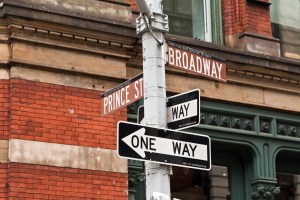Presented By: CBRE
Going Omnichannel—Why It Is Critical for Business
Retailers need an integrated, multi-faceted approach that embraces both online and physical spaces
By Burt Krushenski December 3, 2018 9:30 am
reprints
At least 18 companies that began as online-only retailers now have at least one physical location in Manhattan, including Warby Parker, UnTuckIt, Casper, and the travel-related lifestyle brand Away. Integrated efforts online and in brick-and-mortar stores, known as omnichannel retailing, is quickly becoming retailers’ premier method for maximizing sales.
CBRE, the world’s largest commercial real estate services and investment firm, believes that omnichannel retailing is the way of the future. The firm recently created The Definitive Guide to Omnichannel Real Estate, which is available at cbre.us/omnichannelguide.
“There is a lot of talk about e-commerce retailers competing with brick-and-mortar retailers, and the conventional wisdom is that e-commerce is winning. We know it’s not an ‘either/or’ issue, but a ‘both/and’ approach that seems to be evolving and driving success in the retail business,” said Nicole LaRusso, Director of Research & Analysis for CBRE Tri-State.
“An omnichannel strategy means that retailers need an integrated, multi-faceted approach that embraces both online and physical spaces. People want to migrate seamlessly from online to mobile technology to in-store and back again—embracing this omnichannel strategy is how retailers are meeting their customers’ needs.”
Omnichannel shopping takes many forms. For example, customers can research items online and order them for in-store pickup, a profitable option since, according to a 2017 Harvard Business Review study, prior online research led consumers to 13% greater in-store spending. A retailer can also sell online only, but still employ a brick-and-mortar showroom where sales reps can interact directly with customers and customers can have a hands-on experience with the merchandise. This too can lead to greater sales, as the study showed that omnichannel customers make 23 percent more repeat shopping trips to a store within six months of an omnichannel experience.
The key to success is for the process to be intuitive and seamless for customers. Omnichannel customers (those who shop across multiple channels) spend four percent more in-store and 10 percent more online than single-channel shoppers; they are also more likely to recommend a brand to friends and family when compared to single-channel shoppers. In fact, the study found that the more channels a customer used, the more money that customer spent in-store.
Closing a brick-and-mortar store, meanwhile, has been found to decrease a business’ online sales by up to 20 percent.
Retailers are using new ideas for retail store layouts, including “reconfiguring their stores so the checkout area is smaller. Instead, they have employees roaming the store with handheld devices,” said CBRE’s LaRusso, who notes that this leads to shorter wait times, better approximating the online experience.

“If people can’t find the merchandise they want in the store, the clerk has a Wifi-enabled handheld device to look up where that merchandise is or see if it’s available online. They can do mobile checkout on the spot, and have the product sent to you at home with no shipping cost. It’s a quicker process,” she continued.
Many brick-and-mortar retailers in 2018 already have an online presence of some kind. But for e-commerce merchants looking to broaden their customer base and embrace the world of omnichannel, the segue into brick and mortar can be daunting.
Andrew Goldberg, a vice chairman in CBRE’s retail group, suggested that merchants seeking a brick-and-mortar presence can take advantage of another current trend to lessen some of the risk: the pop-up store.
“Most of the e-commerce businesses coming to street retail are opening as pop-ups or with short-term lease obligations,” said Goldberg. “Operating in New York City is expensive. Short-term leases give retailers the ability to see how they’re doing in the brick-and-mortar world.”
Goldberg also noted that e-commerce merchants are already well-versed in accumulating and interpreting data. This will help them evaluate the effectiveness of a brick-and-mortar outlet.
“Online businesses are not necessarily tracking just sales – they are gathering a variety of information from their online customers, like what area of the county they live in or what type of products they purchase most frequently,” he said.
“When retailers open a store in a particular location, they can see how it’s affecting their online business. Are they getting an increase in users and sales? If so, is it an increase from existing customers, or are they seeing new customers? Are the existing customers buying different merchandise than they were previously, or more of the same? They get to really understand the analytics of the business—what the brick-and-mortar store is telling them versus what they know from the online business.”
In New York, e-commerce retailers testing the brick-and-mortar waters have some advantages, as the city’s shifting retail landscape means opportunities for flexible leases, lower rents, and greater concessions.
“There has been a decline in the price of retail space here,” said LaRusso. “Landlords are not only dropping their rents, they are negotiating or giving free rent. They’re giving allowances in bigger numbers than they had before, and that has created new opportunities for retailers.”

“A lot of online-only retailers are looking at the New York market and saying, ‘This is a great place for me to have one or maybe a handful of real-life storefronts where I can connect to my customer, in a place that has high visibility and a lot of foot traffic.”
On this front, CBRE has made significant investments in new technology to provide potential brick-and-mortar retailers with information to help them take that next step. Mobile Insights is part of that new technology.
Mobile Insights is a proprietary system, developed by CBRE and available to the company’s Manhattan retail brokers and their clients. The technology uses publicly available data from cell phones and wearable GPS devices to provide street retailers, and those evaluating opportunities for such, with comprehensive data on how people interact with specific locations.
“Mobile Insights allows you to analyze data to paint a picture of demographics, shopping patterns, pedestrian foot traffic and more. You can go into some very granular detail,” said Matt Chmielecki, a senior vice president in CBRE’s retail group.
“By focusing on a specific site—say, a storefront on Madison Avenue between 60th and 61st Streets—Mobile Insights can determine how many people walked by, how much time they spend on the block, where they’re from, and the ratio of local vs. non-local passersby. If your target market includes Asian consumers, for example, you can identify how many Asia-based tourists walk by. You can also analyze the strength of a location by seasons or even months. These are all things tenants look for. Mobile Insights takes the guesswork of site selection and marries that with solid data.”
Mobile Insights also allows retailers to follow the path customers and potential customers took on their way to and from the store.
“You can not only find out where they were, you can identify where they went next, and where they were two hours before,” he said. “You’re actually able to track groups of anonymous users that have passed, in what we call a ‘shopper’s path of purchase.’ If you realize that, ‘our Union Square store has a huge amount of people from Williamsburg coming to it,’ then perhaps it makes sense to have a store in Williamsburg.”
By using data to make site selection that much more exact, e-commerce merchants newly embracing omnichannel can make the move to brick and mortar in a way that will ease the trepidation for the retailers, landlords, and investors alike.

The widespread adoption of omnichannel has vast implications for retail real estate, as CBRE lays out in the Omnichannel Guide.
For many retailers, it means adapting to a new way of working, often maintaining smaller inventories and using more of the brick-and-mortar space for experiences, like Capital One’s recent addition of coffee shops, known as Capital One Cafes, or the ability for customers in Adidas stores to print custom clothing.
For landlords and investors, it means evaluating tenant or investment merchant mixes for those susceptible to online penetration, such as clothing. Shopping malls are particularly vulnerable here via soft goods categories and should look for more brick-and-mortar-reliant business categories like food and beverage or beauty. Lease terms and clauses should also be evaluated.
For retailers online or on the ground, omnichannel marketing will be the key to maximizing sales and customer satisfaction in the years to come.
“We think that omnichannel retailing is the future,” said Goldberg. “The new crop of stores is coming from e-commerce. The omnichannel business is where we’re going to be finding the new tenants.”


